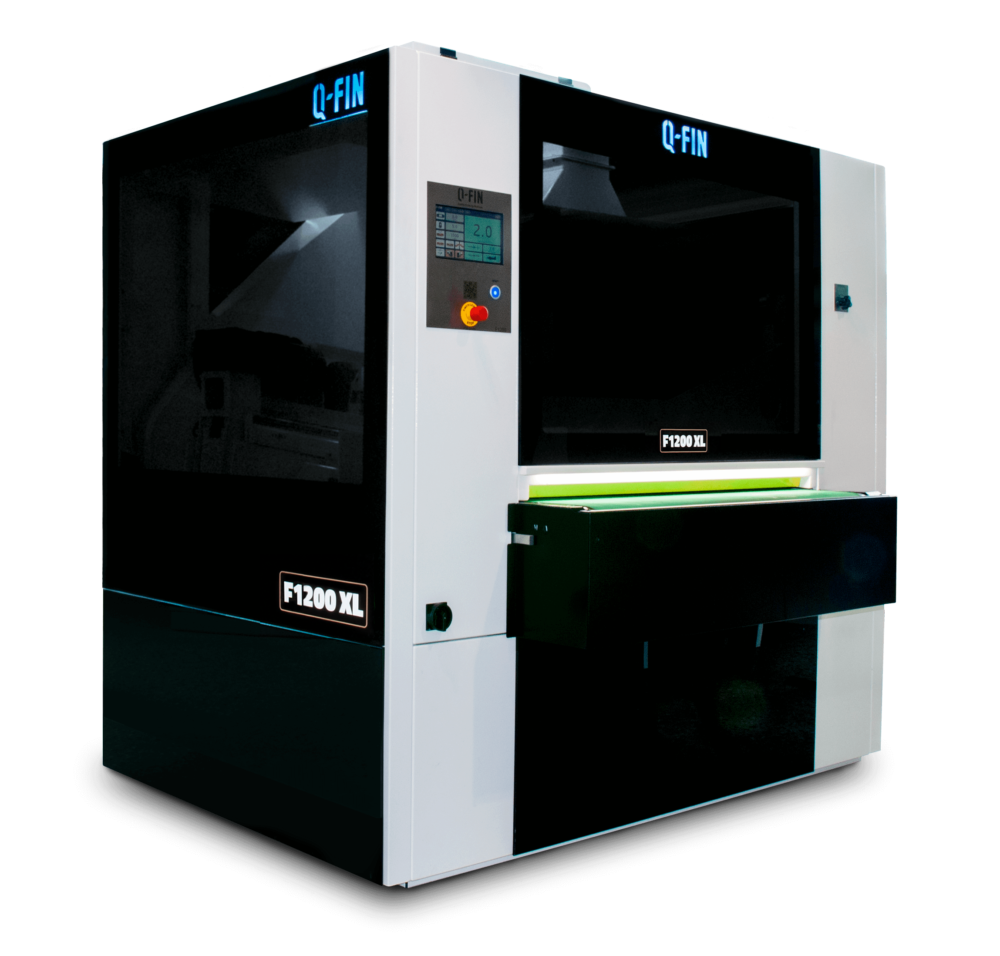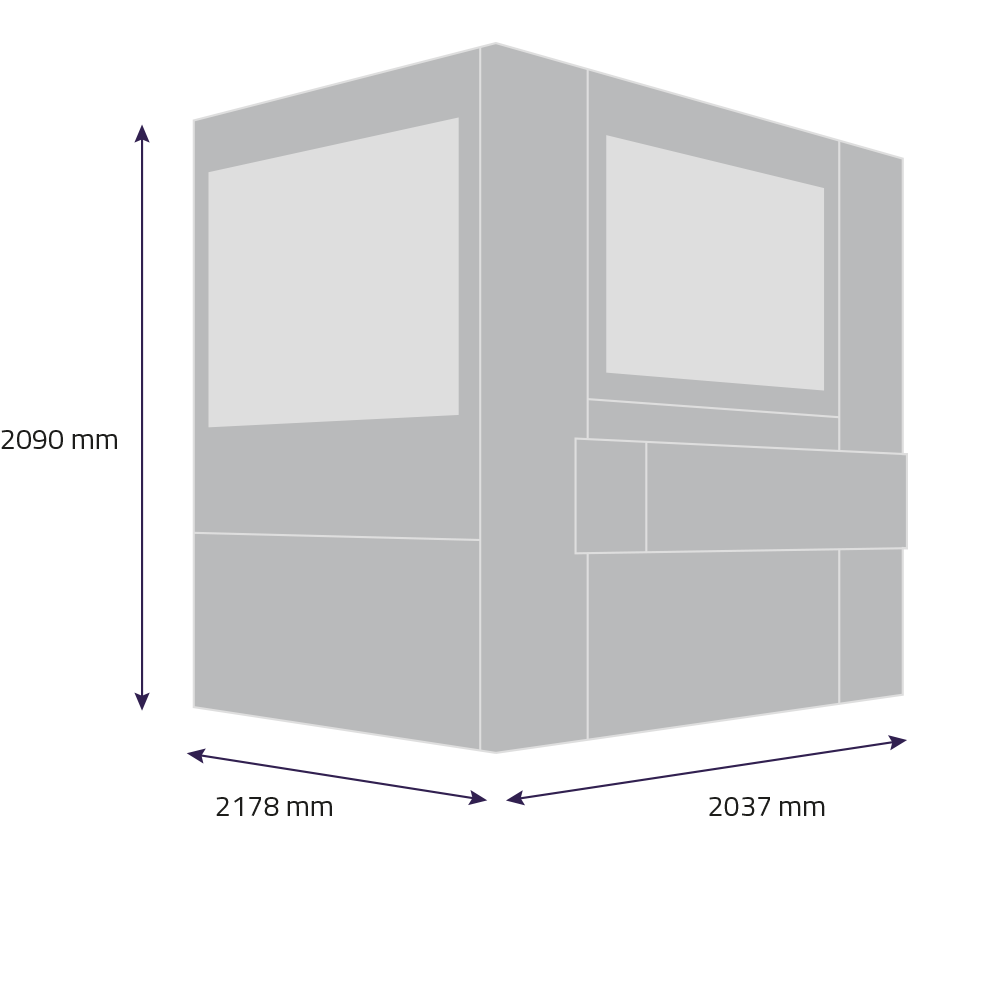F1200 XL

After deburring and rounding of the edges, certain products require an end finish e.g. line graining. Or to refine the linear grinding pattern. The F1200 XL has 4 machining stations to be able to realize this and is delivered full options including automatic height adjustment on the brush engines and grinding belts. With 4 stations on barely 2 meters this finishing machine is particularly compact.
Line grain grinding, also known as a line grain finish, is the most common finish for metal, especially for stainless steel. Stainless steel components with a line grain finish are often used for visible work: products such as extractor hoods. Usually a grain size is indicated for grinding, that indicates how finely the surface is grinded. The higher the number, the finer the grain. For example, G320 stands for a 320 grain.
With the machines of Q-fin you can give products of 10 mm wide up to 1200 mm wide the grinding structure you choose, from G40 to G320. A finish with Scotch-Brite is also part of the possibilities.
The harsh environment of the metal processing industry is one that relies particularly on strict health and safety rules, as well as precise timelines and the ability to meet deadlines without fail. Downtime is something that can cause much larger issues in the long run, so the investment into professional slag removal is an issue that should be addressed as soon as possible.
Metal waste or particles can be caused by a number of processes, including the essential maintenance task of deburring metal machinery parts. Without this, machinery parts would degrade quickly, leading to the necessary and expensive replacement of not only the part itself, but also damaged output and other surrounding machinery. There is also the further complication that without the removal slag process, the safety of workers could be at risk.
Our range of finishing machines are made to tackle the harshest of environments and can handle a specific range of metals that can be tailored to suit your business. We offer both static and mobile options which can complete the finishing process and
removal of slag all at the same time. Slag removal is a natural part of our machinery operations as the processes of smoothing, grinding and edge rounding can all produce excess waste metal that needs to be safely disposed of. We offer various methods for this and are happy to discuss the best option for your workplace, depending on your particular equipment.
The removal slag process is often seen as one of the smallest required but its effects are without a doubt much bigger. Without an efficient removal option, waste metal parts could prove to be extremely hazardous both for staff and other machinery parts, so it is vital that you find a professional solution for removal of slag to fully suit your needs.
With cutting processes such as laser cutting, plasma cutting and water jet cutting, burrs can occur on the metal workpieces. These sharp, protruding imperfections are undesirable for multiple reasons. Deburring is therefore necessary to remove them.
Q-fin has developed an innovative machine line for the mechanical, fast, proper and easy deburring of steel, aluminium and stainless steel sheet components. Hence, there is always a machine that deburrs your product(s) in a satisfactory manner. Against low costs, with a high speed and easy to operate. The machine can of course also be used for removing burrs as a result of other processes such as cutting, sawing, punching and/or stamping.
An oxide film is a hard layer that remains on the cut edges after cutting. This film exists of material that has reacted to oxygen. An oxide film usually occurs with plasma cutting and laser cutting with oxygen.
With the deburring machines of Q-fin, in combination with the right grinding materials, you can easily remove this oxide film.
Grinding is a machining technique whereby material is removed with the use of an abrasive belt or grinding disc. With grinding you can remove burrs from a product, remove imperfections or apply a specific abrasive structure to the material.
To remove damages, small indentations and a hard mill scale, often coarse abrasive belts or grinding grains are used, for example a Grain 40 (G40) or a Grain 60 (G60). When all imperfections are removed from the metal, it is possible to apply a surface finish. A frequently chosen finish is the G320 grain, a nice and neat abrasive structure that is also much smoother than the G40 or G60.
At Q-fin we have both manual and fully automatic grinding machines. We gladly advise you on the right machine for your grinding operations.
Grinding is possible at multiple gradations of roughness. The roughness value of the product surface is indicated by a number. Generally, the average roughness is considered for this purpose, indicated with ‘Ra’. The desired roughness is related to the application of the product. Whether it should be free from attached micro-organisms, whether it is a visible object or not, etc.
At Q-fin we have machines for the grinding at every desired roughness and in accordance with all customer specifications and prescribed requirements and standards. By means of a demo at our company in Bergeijk we gladly show you everything that we are able to achieve.
Most customers require edge rounding or at least edge breaking of the edges of metal workpieces. Otherwise, the staff members in manual assembly processes and end-users may injure their hands. Therefore, they must be extremely careful when manoeuvring the workpieces, so they cannot work quickly. Often customers provide specifications for a certain consistent radius to the product.
Depending on the objective, Q-fin can, with its machines, assign a constant radius in one passage by breaking or rounding edges in accordance with the requested radius. We ensure an optimal configurable edge rounding.
Q-fin offers you standard a combination of deburring, grinding and edge rounding in 1 machine.
“Their story is just right. It comes from people who really work in the field and know what’s being requested. The showroom, the open assembly hall and the knowledge centre also make Q-Fin’s accommodation in Bergeijk look great. That gives you as a customer a lot of confidence. We can process 70 to 80 percent of the parts we cut on this machine. The quality is now super. Our people now have a maximum of one and a half to two hours of pleasure behind the machine every day. The machine is very easy to operate. We can also easily leave it to trainees. You can’t make mistakes. It saves us a lot of money. It will repay itself within a year and we will achieve a great improvement in quality.”
– Aad Reuring
Director at Reurings Precision Sheetmetal


– Conveyor belt speed adjustable: 0.3 – 8 m1/min
– With vacuum or magnetic support
– 2 pcs. 7,5 kW grinding units with frequency control
– 4 pcs. 2,2 kW brush motors with frequency control
– Min. workpiece dimensions: 50×50 mm (MAG) / 80×80 mm (VAC)
– Maximum workpiece width: 1200 mm
– Maximum workpiece height: 170 mm
– Machine power supply: 400 V, 50 Hz, 63 A, 25 kW
– Dimensions: 2040 x 2180 x 2090 mm (L x W x H)
 3.050 KG
3.050 KG